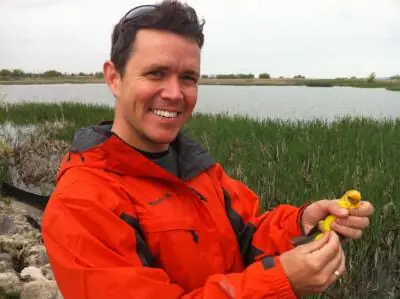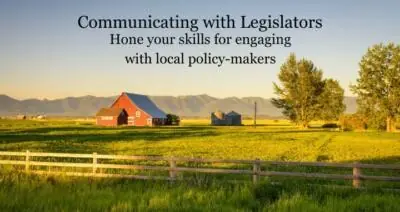The Role of Long-Term Research in Sustainable Agriculture
Written by Elizabeth Tobey
The word unprecedented has become tiredly overused, as we weather the storms of one climate-induced disaster after another, and set new records for temperature extremes. Farmers and farm workers in particular are keenly aware of the impacts of this climate chaos; in a profession dependent on and deeply affected by the weather, people working in agriculture are canaries in the coal mines of rapidly changing weather patterns and new climate extremes. Earlier this year farmers in Vermont raced to harvest crops before flood waters overtook fields and contaminated crops, while farmers throughout the west coast donned n95 masks or respirators to work the fields amid hazardous air quality due to a wildfire smoke. These stories are sadly not uncommon; everywhere you look farmers are working hard to stay afloat in challenging conditions. Climate change is impacting farms and ranches across the nation and organic farms are particularly vulnerable; but they are also full of potential for climate adaptation and even mitigation.
A recent Civil Eats article showcased how the history of extractive agriculture in Maui set the stage for the devastating wildfires in early August. While it explains the tragic history leading up to the disaster, it also points out that agriculture can be part of the solution. “Basically everything that can be done negatively, agriculture can also do it positively. Agriculture can contribute to soil remediation, improved water quality, and biodiversity.”
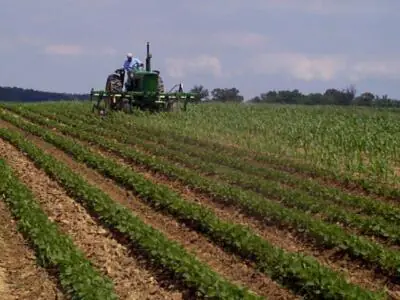
Cultivating corn at the Sustainable Agricultural Systems Lab in Beltsville, MD, with cultivated beans in the foreground
Because organic farms do not rely on synthetic chemicals, they tend to be more dependent on natural systems than their conventional farming counterparts. This can mean they are more vulnerable and easily impacted by climate change, but organic systems also hold tremendous potential to build climate resilience. Farmers have always adapted, and the unpredictability of our current climate continues to push farmers to seek innovative solutions and evolve their farming practices to help withstand and even mitigate the extremes of climate change.
Long term agroecological research is critical in order to provide farmers with cutting edge understanding of how climate change affects different production systems and how different production systems can build resilience to withstand climate change. While a lot can be learned in short-term studies, there are things that only long-term observation can reveal. To better understand the role of long term agriculture research OFRF recently spoke with Michel Cavigelli, PhD about his work at the long term agricultural research (LTAR) station in Beltsville Maryland, ancestral homelands of the Piscataway and Nacotchtank. “I was always interested in long-term research because everything changes every year,” Cavigelli said.
Weather patterns can change so much year to year, that a two year study, for instance, may fall over the course of two good-weather years, or even a good year and a bad year, and the results will not accurately represent the full picture of how a farming system behaves over the course of several years and weather cycles. Other elements of agriculture change so slowly that it’s nearly impossible to measure them in a short period of time.
“You need long term data to look at things that change a lot from year to year, and you also need long term data to look at things that change slowly,” Cavigelli explained. “Soil organic carbon changes slowly, that’s probably the most notorious one. You usually need at least ten years of a treatment difference to see those [changes] statistically.”
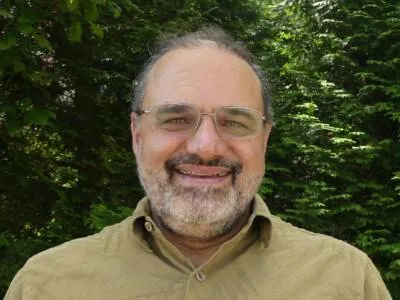
Dr. Michel Cavigelli
Running a long-term study offered Cavigelli a unique opportunity to study Soil Organic Carbon (SOC). “There’s all this talk now about climate-smart agriculture, and looking at ways to mitigate greenhouse gas emissions in agriculture. So any increase in soil carbon is a decrease in atmospheric carbon.”
At the Beltsville research site they have five different cropping systems in place: two conventional and three organic, with a variety of tillage practices and crop-rotations in place. The cropping systems they maintain are:
- Conventional
- no-till, 3-year corn-soybean-wheat rotation
- standard tillage, 3-year, corn-soybean-wheat rotation
- Organic
- standard tillage, 2-year corn-soybean rotation
- standard tillage, 3-year corn-soybean-wheat rotation
- standard tillage, 6-year corn-soybean-wheat-alfalfa rotation, with alfalfa as a three-year perennial crop
The conventional systems receive a double-cropping of soybeans after wheat harvest, while the three-year organic rotation gets a hairy vetch planting. “It’s still corn, soybean wheat, and then a legume,” said Cavigelli, of the 3-year organic rotation. “So it’s quite comparable to the two conventional systems.” This variety of cropping systems allows them to compare different production methods.
Along with studying SOC, Cavigelli also looks at crop yield, economic viability, soil quality and soil properties, weed population dynamics, and the overall health of the soil food web. He also explained the long term trial site functions as a base for other researchers to look at things that they don’t study at the Beltsville lab, such as soil invertebrate communities. “We provide the long term study for people to kind of helicopter in and do their specialty, which provides a lot more depth of knowledge of the different systems,” Cavigelli said.

Organic soybeans at the Sustainable Agricultural Systems Lab in Beltsville, MD
The results of these studies help researchers like Cavigelli give more accurate and useful advice to farmers and ranchers. Along with publishing scientific reports on their findings, researchers at Beltsville engage in a variety of outreach activities to share their findings with the agricultural community. Prior to Covid, Cavigelli said he regularly presented at ag conferences and hosted field days at the research site that would draw groups of 80-100 farmers and others at a time. He also worked with partners at the local university extension office on a “traveling road show” tour to present findings to ag communities in the mid-Atlantic region, and is eager to reinstate those outreach activities now that the national emergency has ended.
There have been a lot of studies on no-till conventional agriculture, which allowed people to develop some robust conclusions early on. “That’s why no-till became the focus of what farmers ought to do to sequester carbon,” Cavigelli said. Based on this he explained that his initial hypothesis was that the organic systems would retain soil carbon at a rate somewhere between the conventional tillage and conventional no-till systems, taking into account the added organic matter from the organic systems but the disturbance from tilling.
Some of the initial results they’ve found in studies have surprised even Cavigelli. He initially expected the no-till systems to have higher SOC levels because of the decreased soil disturbance. However, when they looked at the findings after 11 years, the organic system actually had more soil carbon than the no-till system, although he made sure to point out that their latest study on SOC has not been fully vetted by peers yet; they will be submitting the paper soon.
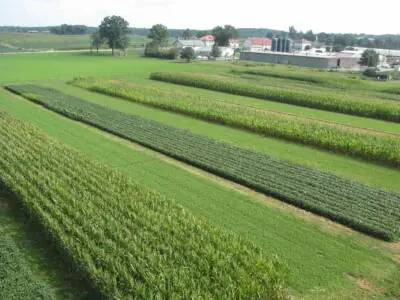
Farming Systems Project, Sustainable Agricultural Systems Lab in Beltsville, MD
“A critical part of the story is that when the experiment was started we had relatively high SOC because the site had been planted to perennial alfalfa for at least 14 years,” Cavigelli said. “This also points to the value of perennials.” When Cavigeli’s team compared their results to archived soil samples from 1996, before the long-term systems trials began, the only cropping system that was not losing soil organic carbon over the long term was the 6-year organic rotation. As noted above, this rotation differs from the others by adding a three-year planting of perennial alfalfa before going back into an annual corn-soybean-wheat rotation. “It’s not a tree, it’s not the native perennials, but it’s still a perennial,” Cavigelli explained about the alfalfa. “And during the three years that it’s in there you’re not tilling, and you’re increasing root biomass and all that.” As a legume, the alfalfa roots have a symbiotic relationship with rhizobial bacteria that pull atmospheric nitrogen from the air and fix it in the plant, while the perennial root systems and the lack of tillage or soil disturbance for those three years support the soil in sequestering carbon. Alfalfa is also a valuable cash crop in itself, providing high quality livestock feed.
“When we look at the difference between time-zero, 1996, and all five of our systems they all lose carbon except for the six-year organic system,” Cavigelli said. “It’s not just that it’s organic, but it’s that we have a perennial in there. So it looks like the story is that perennials are the best way to either maintain or increase soil carbon.”
As we head into the unknown of our changing climate, long-term research will be increasingly important to help farmers and ranchers make informed decisions about their management practices and to help policy makers respond to the climate crisis with effective programs. However, funding for these long term projects is precarious. All the funding comes from Congress, and Cavigelli explained that it can be tough to make the case for long-term research. “They like to see more quick results, and it’s not quite as sexy as developing a new technology,” he laughed. Researchers like Cavigelli are limited by Congress’s funding decisions. “It’s a harder sell,” Cavigelli continued. “And it’s a sustainability sell. The only way to measure our sustainability is doing things long-term. And the amount of money we get is directly related to how much research we can do.”
. . .
Dr. Michel Cavigelli is a Co-Director of the USDA Northeast Climate Hub, providing expertise on cropping system management and impacts on greenhouse gas emissions. He is also a Research Soil Scientist with the USDA Agricultural Research Service at the Sustainable Agricultural Systems Lab in Beltsville, Maryland. He serves as Lead Scientist of a research project that includes evaluating the long-term impacts of organic and conventional cropping systems management on sustainability. His areas of expertise include organic and conventional cropping systems, nutrient management, and environmental and microbiological controls on soil nitrous oxide production and emissions. He received a B.A. in Biology at Oberlin College in 1984, a M.S. in Agronomy at Kansas State University in 1990, and a Ph.D. in Crop and Soil Sciences and Ecology and Evolutionary Biology at Michigan State University in 1998. OFRF is grateful to Cavigelli for taking the time to speak with us about his work.



